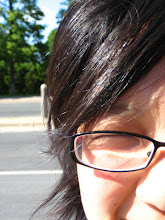(That sentence, by the way, should be pronounced with an emphasis upon every word, slow and punctuated with no small sense of gravity. Let's try again.)
I love cake.
(Yes. Very good.)
Whether dense and bready like a cornmeal cake, or an airy layered confection cool from the fridge, I have since childhood conducted a long and sustained love affair with anything taking cake form. Cakes can be comfortable, impressive, assuring, sublime; they make the most lovely gifts on any occasion, but are equally enjoyable lifted silently in the night, cut off sliver by innocent sliver.

This particular cake is a knock-out. Though it reads like a carrot cake, it also asserts itself a bit beyond the paradigm with its subtle pear taste and sophisticated frosting made with lemon and honey. And it's easy. So very, very easy.
Pear Cake with Lemon-Honey Cream Cheese Frosting
adapted from epicurious.com
For the cake:
2 cups all purpose flour
1 1/2 cups sugar
2 tsp. baking soda
1 tsp. salt
2 tsp. ground cinnamon
3/4 tsp. ground nutmeg
3/4 cup vegetable oil
2 large eggs
1/3 cup whole milk
1 1/2 tsp. vanilla extract
3 cups coarsely grated peeled Bosc pears (from about 3 pounds), well drained
1/2 cup walnuts, toasted, chopped
For the frosting:
1 package cream cheese (here's where you could use more; the recipe cut off so I wasn't sure)
1/2 cup (1 stick) unsalted butter, room temperature
1 cup powdered sugar
2 tsp. vanilla extract
2 tsp. grated lemon peel
3/4 cup honey
For cake: Preheat oven to 325°F. Butter and flour two 9-inch-diameter cake pans with 1 1/2-inch-high sides. Whisk flour, sugar, baking soda, salt and spices in large bowl. Make well in center of flour mixture. Add oil, eggs, milk and vanilla; whisk just until evenly moistened. Fold in pears and nuts; divide between pans.
Bake cakes until tester inserted into center comes out clean, about 45 minutes. Cool cakes in pans on racks.
For frosting: Beat cream cheese, butter, powdered sugar, vanilla and lemon peel in large bowl until fluffy. Add honey and beat until smooth. If frosting is very soft, chill until firm enough to spread.
Cut around cakes; turn out of pans.* Place 1 cake layer, flat side up, on platter. Spread with 1 cup frosting. Top with second layer, flat side down. Spread remaining frosting over top and sides of cake.
*or if you're like me and only have pie pans, turn it out of the pan and then cut each layer into a more circular shape, using the base of the pie as your guide. This yields a smaller, but arguably more endearing cake. The best part about this is your leftover scraps, which you can frost:
 ...and then eat for yourself. It's the gift that keeps on giving!
...and then eat for yourself. It's the gift that keeps on giving!



